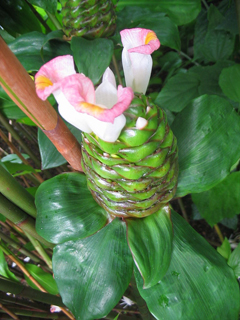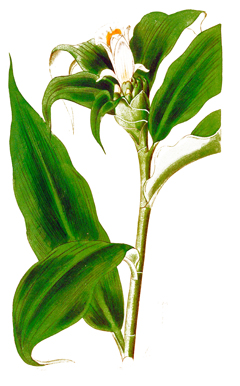 |
|
https://edibleplants.org/ |
 |
| https://edibleplants.org/ |
Translate this page:
Summary
Spiral ginger or Ginger Lily (Costus afer) is a tropical perennial herb known as a medicinal plant in tropical Africa. Different plant parts are used in the treatment of a wide range of illnesses or conditions such as cough, nausea, arthritis, sore throat, epileptic attacks, worms and haemorrhoids, jaundice, urethral discharges, venereal diseases, colic, tachycardia, stomach discomforts, malaria, eye conditions, diarrhoea, and leprosy. The leaves are edible which have an acid flavour. The rhizome is occasionally used as a spice or flavouring. The strips from the stem are made into basket and the stem bark is used to make table mats, papers, and baskets as well.
Physical Characteristics

 Costus afer is an evergreen Perennial growing to 4 m (13ft) by 4 m (13ft) at a fast rate.
Costus afer is an evergreen Perennial growing to 4 m (13ft) by 4 m (13ft) at a fast rate.
See above for USDA hardiness. It is hardy to UK zone 10. The flowers are pollinated by Insects.
Suitable for: light (sandy), medium (loamy) and heavy (clay) soils and prefers well-drained soil. Suitable pH: mildly acid, neutral and basic (mildly alkaline) soils and can grow in very acid soils.
It can grow in full shade (deep woodland) semi-shade (light woodland) or no shade. It prefers moist soil.
UK Hardiness Map
US Hardiness Map
Synonyms
Costus anomocalyx K.Schum. Costus insularis A.Chev. (Invalid). Costus littoralis K.Schum. Costus obl
Plant Habitats
Edible Uses
Edible Parts:
Edible Uses: Condiment
Leaves[ 299 ]. An acid flavour[ 299 ]. The rhizome is occasionally used as a spice or flavouring.
References More on Edible Uses
Medicinal Uses
Plants For A Future can not take any responsibility for any adverse effects from the use of plants. Always seek advice from a professional before using a plant medicinally.
Abortifacient Anaesthetic Anodyne Antiarthritic Antibacterial Antibilious Antidiarrhoeal Antifungal
Antihaemorrhoidal Antiinflammatory Antirheumatic Antispasmodic Antitussive Cancer Cardiac
Cytotoxic Diuretic Diuretic Dysentery Epilepsy Febrifuge Hypoglycaemic
Hypotensive Leprosy Malaria Ophthalmic Parasiticide Rubefacient Skin
Stomachic
Spiral ginger is commonly used as a medicinal plant throughout tropical Africa and modern research has borne out the validity of many of its uses[ 299 ]. The stem, seeds and rhizome contain several steroidal sapogenins, of which diosgenin is the most important one. The rhizome yields 0.5% diosgenin. Diosgenin is a very important raw material used as a precursor in the synthesis of a number of steroidal drugs, including corticosteroids, sex hormones, oral contraceptives and anabolic agents[ 299 ]. The rhizomes also contain the saponins aferosides A and C, as well as dioscin and paryphyllin C and the flavonoid glycoside kaempferol 3-O-a-L-rhamnopyranoside. The last compound showed an ability to potentiate in vitro cisplatin cytotoxicity in a human colon cancer cell line[ 299 ]. A papaverine-like alkaloid is found in the rhizome which causes relaxation of smooth muscle and is an anti-spasmodic, diuretic and central nervous system depressant[ 299 ]. The methanol extract of the rhizome showed significant topical anti-inflammatory activity[ 299 ]. The saponin fraction from the rhizomes and the methanolic leaf extract showed significant abortifacient activity[ 299 ]. Sesquiterpenoids are the most abundant group of volatile compounds in the essential oil of the leaves[ 299 ]. The essential oil did not show any antimicrobial activity[ 299 ]. The aqueous extract of the leaves and stems showed significant antibacterial and amoebicidal activity in vitro[ 299 ]. The methanolic leaf extract showed significant cytotoxicity[ 299 ]. The same extract showed moderate local anaesthetic activity[ 299 ]. The extract exhibited antihyperglycaemic activity, and decreased the blood glucose level when applied in small doses; higher doses, however, increased the blood glucose level[ 299 ]. A decoction of the powdered fruits is used as a cough medicine[ 46 ]. The stem is strongly diuretic[ 299 ]. The debarked stem is chewed to alleviate nausea and quench thirst[ 46 , 299 ]. A stem decoction, the mashed or chewed stem or the pounded fruit, sometimes mixed with sugar cane juice, are taken to alleviate nausea; to treat rheumatoid arthritis; cough respiratory problems and sore throat[ 299 ]. A cold water extract of the stem is taken to treat small epileptic attacks[ 299 ]. The powdered stems are used as an enema to treat worms and haemorrhoids[ 299 ]. The smoke of the dried stem is inhaled to treat coughs[ 299 ]. The stem sap is used to treat jaundice and to prevent miscarriage[ 299 ]. The stem sap is acid and rubefacient and burns on open wounds, but it is also anodyne and healing[ 299 ]. It is applied externally to treat a range of skin ailments; urethral discharges and venereal diseases[ 299 ]. It is also rubbed on the body to treat colic[ 299 ]. An infusion of the inflorescence is taken to treat tachycardia[ 299 ]. The same infusion or a rhizome infusion is taken to treat stomach complaints[ 299 ]. The leaf sap, or a rhizome decoction, is taken to treat malaria[ 299 ]. Externally, the leaf sap is used as eye drops to treat eye troubles and as nose drops to treat headaches with vertigo[ 299 ]. It is used in frictions to treat oedema and fever[ 299 ]. An infusion of the dried aerial parts is taken to treat hypertension[ 299 ]. The pulp of the rhizome is applied to abscesses and ulcers to mature them; it is applied to teeth to cure toothache, and mixed with water it is taken internally to treat diarrhoea and amoebic dysentery[ 299 ]. A rhizome decoction or the raw rhizome is taken to treat leprosy and venereal diseases[ 299 ].
References More on Medicinal Uses
The Bookshop: Edible Plant Books
Our Latest books on Perennial Plants For Food Forests and Permaculture Gardens in paperback or digital formats.

Edible Tropical Plants
Food Forest Plants for Hotter Conditions: 250+ Plants For Tropical Food Forests & Permaculture Gardens.
More

Edible Temperate Plants
Plants for Your Food Forest: 500 Plants for Temperate Food Forests & Permaculture Gardens.
More

More Books
PFAF have eight books available in paperback and digital formats. Browse the shop for more information.
Shop Now
Other Uses
Basketry Cosmetic Essential Fibre Latex Paper Parasiticide
Other Uses: Strips made from the outer stem are made into baskets[ 46 ]. It is sometimes cultivated for the stem bark which is used to make table mats and baskets[ 299 ]. Experiments to use the stem for making paper have been successful[ 299 ]. The stems are used in house construction[ 299 ]. The sap can be used to coagulate latex and is also used in skin nourishing creams[ 299 ].
Special Uses
References More on Other Uses
Cultivation details
Prefers a very fertile, moist but well-drained acid soil and a position in some shade[ 200 , 299 ]. Plants also succeed in full sun[ 299 ]. Spiral ginger is a very vigorous grower. It flowers and fruits throughout the year, depending on the humidity of the soil[ 299 ].
References Carbon Farming Information and Carbon Sequestration Information
Temperature Converter
Type a value in the Celsius field to convert the value to Fahrenheit:
Fahrenheit:
The PFAF Bookshop
Plants For A Future have a number of books available in paperback and digital form. Book titles include Edible Plants, Edible Perennials, Edible Trees,Edible Shrubs, Woodland Gardening, and Temperate Food Forest Plants. Our new book is Food Forest Plants For Hotter Conditions (Tropical and Sub-Tropical).
Shop Now
Plant Propagation
Seed - best sown fresh[ 200 ]. Germinates best at a temperature of 20c[ 200 ]. Division[ 200 ]. The rhizomes are cut into pieces 2.5 cm long and planted in a mixture of sand and peat moss[ 299 ]. Cuttings of stem sections[ 200 ]. The stems are cut into pieces 2.5 cm long and planted in a mixture of sand and peat moss[ 299 ]. Bulbils sometimes develop in the enlarged fruit head of some species. These can be potted up and will grow into new plants[ 200 ].
Other Names
If available other names are mentioned here
Spiral ginger or Ginger Lily (Costus afer). Also known as: Gododje-sato, Gogodje-suto, Kostus spiral putih, Rum-rum, Spiral Ginger, Ginger lily, White spiral costus.
Native Range
AFRICA: Kenya, Tanzania, Uganda, Central African Republic, Cameroon, Democratic Republic of the Congo, Benin, Côte D‘Ivoire, Guinea, Liberia, Nigeria, Senegal, Sierra Leone
Weed Potential
Right plant wrong place. We are currently updating this section.
Please note that a plant may be invasive in one area but may not in your area so it's worth checking.
None Known
Conservation Status
IUCN Red List of Threatened Plants Status : This taxon has not yet been assessed

Growth: S = slow M = medium F = fast. Soil: L = light (sandy) M = medium H = heavy (clay). pH: A = acid N = neutral B = basic (alkaline). Shade: F = full shade S = semi-shade N = no shade. Moisture: D = dry M = Moist We = wet Wa = water.
Now available:
Food Forest Plants for Mediterranean Conditions
350+ Perennial Plants For Mediterranean and Drier Food Forests and Permaculture Gardens.
[Paperback and eBook]
This is the third in Plants For A Future's series of plant guides for food forests tailored to
specific climate zones. Following volumes on temperate and tropical ecosystems, this book focuses
on species suited to Mediterranean conditions—regions with hot, dry summers and cool, wet winters,
often facing the added challenge of climate change.
Read More
Expert comment
Author
Ker Gawl.
Botanical References
Links / References
For a list of references used on this page please go here
A special thanks to Ken Fern for some of the information used on this page.
Readers comment
| Add a comment |
|
If you have important information about this plant that may help other users please add a comment or link below. Only comments or links that are felt to be directly relevant to a plant will be included. If you think a comment/link or information contained on this page is inaccurate or misleading we would welcome your feedback at [email protected]. If you have questions about a plant please use the Forum on this website as we do not have the resources to answer questions ourselves.
* Please note: the comments by website users are not necessarily those held by PFAF and may give misleading or inaccurate information.
To leave a comment please Register or login here All comments need to be approved so will not appear immediately.
|
|